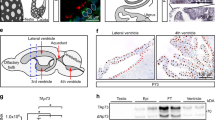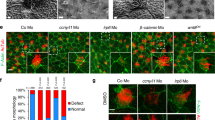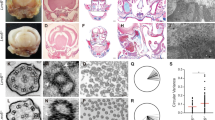Abstract
Background
Motile cilia in a vertebrate are important to sustaining activities of life. Fluid flow on the apical surface of several tissues, including bronchial epithelium, ependymal epithelium, and fallopian tubules is generated by the ciliary beating of motile cilia. Multi-ciliated cells in ependymal tissue are responsible for the circulation of cerebrospinal fluid (CSF), which is essential for the development and homeostasis of the central nervous system, and airway tissues are protected from external contaminants by cilia-driven mucosal flow over the top of the airway epithelium.
Objective
A previous study reported that reduction of Ribc2 protein leads to disruption of ciliary beating in multi-ciliated cells. However, knowledge regarding the molecular function of Ribc2 is limited, thus currently available information is also limited. Therefore, we evaluated the importance of proteins involved in the interaction with Ribc2 in the process of ciliary beating.
Methods
Immunoprecipitation and mass spectrometry analysis was performed for the discovery of proteins involved in the interaction with Ribc2. Expression of the target gene was inhibited by injection of antisense morpholinos and measurement of the fluid flow on the embryonic epidermis of Xenopus was performed using fluorescent beads for examination of the ciliary beating of multi cilia. In addition, the flag-tagged protein was expressed by injection of mRNA and the changes in protein localization in the cilia were measured by immunostaining and western blot analysis for analysis of the molecular interaction between Ribc2 and Ribc2 binding proteins in multi-cilia.
Results
The IP/MS analysis identified Ckb and Ybx2 as Ribc2 binding proteins and our results showed that localization of both Ckb and Ybx2 occurs at the axoneme of multi-cilia on the embryonic epithelium of Xenopus laevis. In addition, our findings confirmed that knock-down of Ckb or Ybx2 resulted in abnormal ciliary beating and reduction of cilia-driven fluid flow on multi-cilia of Xenopus laevis. In addition, significantly decreased localization of Ckb or Ybx2 in the ciliary axoneme was observed in Ribc2-depleted multi-cilia.
Conclusion
Ckb and Ybx2 are involved in the interaction with Ribc2 and are necessary for the ciliary beating of multi-cilia.






Similar content being viewed by others
Availability of data and materials
The data and materials in the current study are available on request.
Abbreviations
- Ribc2:
-
RIB43A domain with coiled-coils 2
- Ckb:
-
Creatine kinase, brain
- Ybx2:
-
Y-box-binding protein 2
References
Chung MI et al (2014) Coordinated genomic control of ciliogenesis and cell movement by RFX2. Elife 3:e01439
Cox J, Mann M (2008) MaxQuant enables high peptide identification rates, individualized p.p.b.-range mass accuracies and proteome-wide protein quantification. Nat Biotechnol 26(12):1367–72
Duff MO et al (2015) Genome-wide identification of zero nucleotide recursive splicing in Drosophila. Nature 521(7552):376–379
Fagerberg L et al (2014) Analysis of the human tissue-specific expression by genome-wide integration of transcriptomics and antibody-based proteomics. Mol Cell Proteomics 13(2):397–406
Fortriede JD et al (2020) Xenbase: deep integration of GEO & SRA RNA-seq and ChIP-seq data in a model organism database. Nucleic Acids Res 48(D1):D776–D782
Hoh RA et al (2012) Transcriptional program of ciliated epithelial cells reveals new cilium and centrosome components and links to human disease. PLoS ONE 7(12):e52166
Ishikawa T (2017) Axoneme structure from motile cilia. Cold Spring Harb Perspect Biol 9(1):a028076
Karunakaran KB et al (2020) Cilia interactome with predicted protein-protein interactions reveals connections to Alzheimer’s disease, aging and other neuropsychiatric processes. Sci Rep 10(1):15629
Khanna H (2015) Photoreceptor sensory cilium: traversing the ciliary gate. Cells 4(4):674–686
King SM (2016) Axonemal dynein arms. Cold Spring Harb Perspect Biol 8(11):028100
Kumar V et al (2021) The regulatory roles of motile cilia in CSF circulation and hydrocephalus. Fluids Barriers CNS 18(1):31
Linck RW, Norrander JM (2003) Protofilament ribbon compartments of ciliary and flagellar microtubules. Protist 154(3–4):299–311
Liu Y et al (2022) mRNA m(5)C inhibits adipogenesis and promotes myogenesis by respectively facilitating YBX2 and SMO mRNA export in ALYREF-m(5)C manner. Cell Mol Life Sci 79(9):481
Norrander JM et al (2000) The Rib43a protein is associated with forming the specialized protofilament ribbons of flagellar microtubules in Chlamydomonas. Mol Biol Cell 11(1):201–215
Olstad EW et al (2019) Ciliary beating compartmentalizes cerebrospinal fluid flow in the brain and regulates ventricular development. Curr Biol 29(2):229–241
Pala R et al (2018) The roles of primary cilia in cardiovascular diseases. Cells 7(12):233
Patir A et al (2020) The transcriptional signature associated with human motile cilia. Sci Rep 10(1):10814
Rao Q et al (2021) Structures of outer-arm dynein array on microtubule doublet reveal a motor coordination mechanism. Nat Struct Mol Biol 28(10):799–810
Ringers C, Olstad EW, Jurisch-Yaksi N (2020) The role of motile cilia in the development and physiology of the nervous system. Philos Trans R Soc Lond B Biol Sci 375(1792):20190156
Satir P, Christensen ST (2007) Overview of structure and function of mammalian cilia. Annu Rev Physiol 69:377–400
Szabo L et al (2015) Statistically based splicing detection reveals neural enrichment and tissue-specific induction of circular RNA during human fetal development. Genome Biol 16:126
van Dam TJP et al (2019) CiliaCarta: an integrated and validated compendium of ciliary genes. PLoS ONE 14(5):e0216705
Wallmeier J et al (2020) Motile ciliopathies. Nat Rev Dis Primers 6(1):77
Funding
This work was supported by the Korea National Research Foundation. (2021R1A2B5B02002285, 2022R1A4A1021318).
Author information
Authors and Affiliations
Contributions
All authors contributed to the conception and design of the study. Material preparation, data collection, and analysis were performed by KYK and DGJ. The analysis of IP/MS data was performed by HJ and TK. The draft of the manuscript was written by KYK and TJP. All authors read and approved the final manuscript.
Corresponding authors
Ethics declarations
Conflict of interest
The authors declare no conflict of interest.
Consent for publication
All authors approved the publication of this manuscript.
Informed consent
Informed consent was obtained from all individual participants included in the study.
Additional information
Publisher's Note
Springer Nature remains neutral with regard to jurisdictional claims in published maps and institutional affiliations.
Supplementary Information
Below is the link to the electronic supplementary material.
Supplementary Movie 1: Movie of fluid flow shown by fluorescent beads over the control embryonic skin Supplementary file1 (AVI 21008 KB)
Supplementary Movie 2: Movie of fluid flow shown by fluorescent beads over the Ribc2 morphant embryonic skin Supplementary file2 (AVI 22119 KB)
Supplementary Movie 3: Movie of fluid flow shown by fluorescent beads over the Ckb morphant embryonic skin Supplementary file3 (AVI 21875 KB)
Supplementary Movie 4: Movie of fluid flow shown by fluorescent beads over the Ybx2 morphant embryonic skin Supplementary file4 (AVI 24344 KB)
Rights and permissions
Springer Nature or its licensor (e.g. a society or other partner) holds exclusive rights to this article under a publishing agreement with the author(s) or other rightsholder(s); author self-archiving of the accepted manuscript version of this article is solely governed by the terms of such publishing agreement and applicable law.
About this article
Cite this article
Kwon, K.Y., Jeong, H., Jang, D.G. et al. Ckb and Ybx2 interact with Ribc2 and are necessary for the ciliary beating of multi-cilia. Genes Genom 45, 157–167 (2023). https://doi.org/10.1007/s13258-022-01350-w
Received:
Accepted:
Published:
Issue Date:
DOI: https://doi.org/10.1007/s13258-022-01350-w




